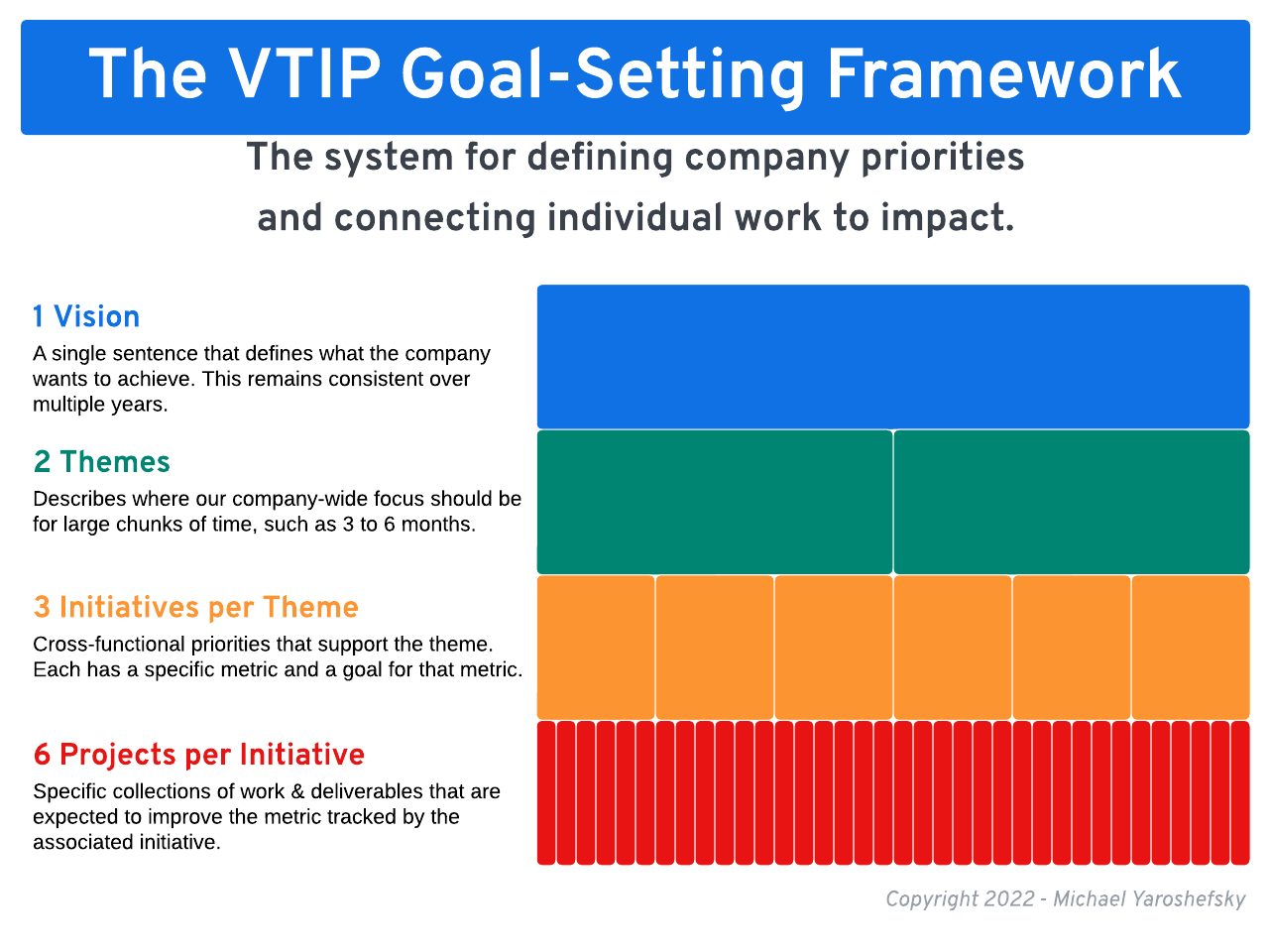
The most important email I write each week
To keep our remote team aligned, I launched a new process exactly one year ago. The team was growing, and we had interns and team members across time zones. We had weekly standups on Monday and Friday to discuss the tactical level, but we needed some way to keep strategic alignment of the team without adding more meeting time. The solution became a weekly email sent at the start of each week to the entire team. We call it the CEO Note.
To celebrate it’s one year birthday, I’m going to share what’s inside it and how it helps us scale Visor:
What’s inside the weekly CEO Note
1) Reminder of Priorities
The biggest mistake leaders can make is failing to communicate the company’s vision & priorities frequently enough.
It can be easy to assume everyone heard the vision & priorities multiple times and got it by now. But our memories aren’t all perfect, and memory drift occurs without repetition. As companies scale, this is where things can fall apart first.
To keep alignment, I list our current Theme and Initiatives at the very top of every email. These are part of our goal-setting methodology called VTIP. It’s our alternative to OKRs that places more emphasis on team goals than individual goals.
Here’s how the VTIP goal-setting framework works:
Vision: A single sentence that defines what the company wants to achieve. This remains consistent over multiple years.
Themes: Describes where our company-wide focus should be for large chunks of time, such as 3 to 6 months. The company should have 1 or 2 active themes at a time.
Initiatives: Cross-functional priorities that are expected to have an impact on some metric. There should be 3-5 Initiatives per Theme.
Projects: Projects are specific tasks linked to initiatives. They are expected to improve the metric tracked by the initiative.

For example, our current main theme at Visor is: Improve the likelihood a new workspace creator experiences Visor’s value. We selected this theme because we want to improve how effective our product is at delivering customer value ASAP via self-service onboarding. We already have customers that get incredibly deep with our product, but the rate at which new users become deeply engaged is lower than we’d like.
Within that theme, we have a few supporting initiatives. Here are the current ones:
- Get new users who claim to use Jira to sync with Jira
- Get syncing users to keep coming back
- ️Get more users to format their data
- Get users to create more views
We picked these initiatives because we expect that achieving them will support our theme. For example, we’ve found that customers who format their data in Visor (i.e. adding colors) tend to retain at a much higher rate than customers who don’t. So we’re attempting to see if getting more users to format their data will also help drive greater retention, which would be a proxy for deciding if they achieved value.
Having one primary theme helps the entire company stay focused. Themes should be company-wide goals that everyone can find ways to contribute to.
Team members lose motivation if they feel like their work isn’t connected to the company’s goals. Worse yet, they feel isolated if they can’t see how others are working towards similar goals.
Having one direction we’re pulling the cart helps everyone feel connected across the company, especially across functional teams like engineering, design, and marketing.
2) Weekly Metrics Report
Setting goals without having ways to measure progress is demotivating, since there’s no concrete validation of the value of work.
To provide clear signs of validation for our work, we’ve integrated a system for KPIs that align to our priorities. Each of our VTIP initiatives has a metric, and each metric has a goal. We report on these metrics each week to track our progress in moving the metrics in the right direction.
For example, here are two initiatives and metrics we’re using for the above:
Initiative: Get new users who claim to use Jira to sync with Jira
Metric: The portion of non-invited new users who claim to use Jira that go on to perform a sync within 7 days of their activation date (measured per weekly cohort after 1 week from the cohort’s last day)
Initiative: Get syncing users to keep coming back
Metric: The portion of non-invited new users who claim to use Jira that go on to perform at least 1 sync in at least 3 different calendar weeks (measured per weekly cohort after 5 weeks from the cohort’s last day)
Sharing these metrics weekly provides everyone on the team with a weekly status of how we’re progressing towards our goals. It also reinforces the importance of picking projects that will show impact.
3) Metric Commentary
Another common leadership mistake is just presenting metrics without analysis. People can look at the same data and draw different conclusions.
Did we expect the metric to move the way it did? Does this movement seem like a blip or a real trend? Which projects that recently launched likely impacted the metric? Providing interpretation of the current metrics and their historic trends delivers the full value of the metrics: meaning.
Beyond sharing how the company is doing, I like to connect the metrics to the team’s work.
Never waste an opportunity to connect positive metric movement to individual work. It’s a powerful motivator to see one’s impact show up in data.
That’s one of the main reasons we developed the VTIP framework – it shows how each team member’s projects connects to the business priorities.
This is also the section where I communicate our north star metric: data transfer. Since our competitive advantage is our integrations, tracking customer usage of the integrations helps us understand the magnitude of value delivered by our product. Also, since data transfer is something users pay for, it’s a precursor to revenue.
4) Last Week Recap
Working in a startup comes with high highs and low lows at the same time. Without framing, it can be confusing and unsettling. Are we doing well or are we failing?
Our weeks can at times be adventurous. We may have substantial wins to celebrate or losses to reflect on. Often we have both in the same week. A few short sentences acknowledging the past week and drawing learnings or takeaways provides a sense of closure and forward motion.
5) Common Threads
Leading a team’s like hovering a helicopter. If you provide course correction too late, chances are you’ll overcorrect and lose stability.
It’s my personal goal to earn a helicopter pilot license. At first, I struggled to bring the helicopter to a stable hover. This is one of the hardest parts of learning to fly. That’s because there’s a long delay between when the pilot provides a control input and the helicopter actually responds. And the controls are incredibly sensitive, so a little correction has a big impact. Most new pilots apply corrective control too late and too strongly. Instead, stable hovering requires making lots of very tiny corrections so quickly that you’re almost making them before you know you need them.
Leading teams feels similar to flying a helicopter. Small changes can have a big impact, but it may take time. That’s why quickly addressing possible course corrections is important. And having a dedicated process for delivering these can help achieve a more subtle “input” at the controls.
For example, we recently realized that we had internal meetings getting booked nearly every day of the week. This left too few blocks of long, uninterrupted time to get deep work done. Addressing that helped us realize the problem and designate Tuesday and Wednesday as days without scheduled meetings.
6) This Week Upcoming
I like to provide an expectation for what this week will bring. This helps the team understand what the purpose of this week will be.
This answers questions lie:
- Do we have any special goals this week?
- Are there any team members off work that week?
- Should this be a week focused on getting things done or are we in a more planning-driven mode?
7) Big Picture
Working deep in the trenches can make it hard to see the bigger picture of how the company’s progressing and what’s going on in our market.
My goal is for everyone to have autonomy to make smart decisions. Even the most junior team members are judged on how well they can understand the overall needs of the business and align their work to that.
Having context to the overall company & market can help making those judgement calls. Here’s what I typically share:
- How is the company performing relative to our overall mission and timeframe?
- Where are we seeing business or product weaknesses we need to address?
- What’s happening in the overall market that impacts us?
8) Reflection on Last Week’s Meetings
Since we record notes from our Monday & Friday standup meetings, I provide links to those notes from last week’s meetings for review.
9) Weekly Pulse Check
When scaling, it’s crucial to keep a pulse on how the team is feeling.
At the end of each weekly CEO Note, I ask every member of the team to provide a simple pulse check. This helps me understand broad shifts in team feelings and identify team members who might benefit from some more 1:1 time. Here are our questions:
- How are you feeling overall? (1-5)
- (Optional) Would you like to share more about why you feel that way?
- I feel appropriately challenged. (1-5)
- I feel supported. (1-5)
- I feel appreciated. (1-5)
- (Optional) If you were CEO, what would you change right now about how we, as a team, do things?
- Are you open to discussing this pulse check with Yaro? (Y/N)
The result is a quick way to understand how the team is feeling, even if we don’t have 1:1 time that week.
Summary
In just 45 minutes each week, writing a company-wide email helps repeat the priorities, share our status, and prepare for what’s to come. This started as an experiment, but as we’ve grown, this has become an indispensable tool for us.
With one year in the books, this has gone from an experiment to a core part of our team’s “operating system.” I just wish I had started this sooner, even when the team was smaller. It has provided a structured way to reflect and plan, which is valuable for any entrepreneur.





